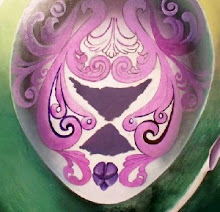I’m using a frisket mask (“stencil”) on a section of my latest piece (“The Golden Thread”), so I decided to share some tips for working with frisket. I used to use lots of frisket in my airbrushed work, but over the years, I’ve used it less and less, usually preferring the look (and convenience) of freehand airbrushing.
I decided to use frisket for the “windowsill” on this piece, though, for two reasons. First, because the windowsill is all straight, perspective lines (and relatively thin lines, at that) it would be difficult to airbrush them freehand, and have them look straight, smooth, and precise.

Second, since the vast majority of my “older” work relied on frisket to give it that “hard-edged” look, keeping that look for a portion of this piece provides a visual “link” between this piece, and my older, airbrushed, science fiction stuff.
Frisket is a thin sheet of clear vinyl or plastic, with an adhesive on one side. It is sold in rolls or sheets in various sizes, and the adhesive side is protected by a non-stick paper backing. The thickness of the frisket can vary from very thin (and hard to manage) to rather thick (and also hard to manage). Frisket has a matte or a glossy finish, and it can have either a strong adhesive (high tack), or a weaker adhesive (low-tack). (I prefer the low-tack, matte finish.)
Once you have your drawing worked out (for frisket work, you can’t be too precise!) cut a section of frisket large enough to completely cover the area you want to paint, leaving enough additional coverage outside that area, to catch any overspray. Carefully remove the backing paper, and gently lay the frisket on the area to be painted. Press it gently into place, smoothing it from the center outward, to avoid bubbles.
Using a X-Acto knife (with a fresh, sharp blade!) carefully cut the shape you want to paint, and (carefully) remove the frisket covering the area to be painted. Thin frisket may tear, and come off in sections, so make sure to completely “open” the area. (Any frisket left where you don’t want it, will block whatever it’s covering, preventing that area from being painted.)
Always make sure you have enough frisket around the area, to block any overspray. Or, you can masking tape to attach scrap paper to the edges of the frisket. Make sure the paper extends to the edges of your work, and use enough tape so there are no gaps along the edge where the paper meets the frisket.
(Using scrap paper means you don’t have to use as much frisket.; a good thing, since frisket is more expensive than scrap paper and masking tape!)
(I used scrap paper along one edge, but the rest of the painting was frisketed, so what I was doing would be clearer.)
One important thing to remember: if you’re using frisket for an area with multiple sections of a similar colour to each other, you don’t have to paint each section separately, re-frisket each section separately—as long as the same basic colour-scheme applies to the entire area.
Since the window-frame will be painted basically blue-grey, as long as I work from dark to light--“opening” the darkest section first, then the next-darkest, and so on, all the way to the lightest section--I can leave each previous section “open”, as I paint the next, successively-lighter sections. You do have to “plan” your piece in advance (a clear, accurate drawing is essential) so you know where the darkest sections are, the next-to-the-darkest, etc.--so you can open them in the proper order, darkest to lightest.

And you’re ready to paint the first area. Build the colour up gradually; using multile less-intense layers, rather than trying to get to the full intensity you want, in one or two passes. Start and stop your strokes well beyond the edges of the frisket; often, when you change direction with your airbrush, a hesitation mark (“barbell”) of intense paint will show at the end of each stroke, and you don’t want that on the open area you’re painting!
Keep your practice mark on the frisket or scrap paper.

So, after you have the darkest area painted to your satisfaction, proceed to the next-to-the-darkest area, and so on. Continue working until you have the entire area painted. Then, remove the remaining frisket, and figure out which section is next, and go for it!

Don’t forget to clean your airbrush as you go, and especially when you’re done for the day, according to the cleaning tips I posted in the previous entry.
Have fun!

No comments:
Post a Comment